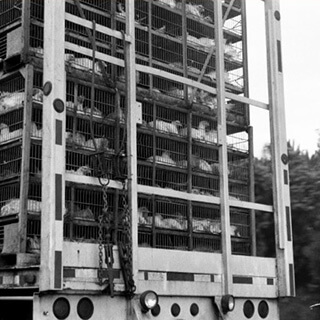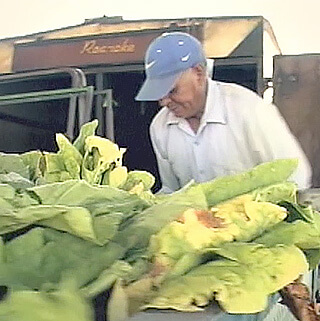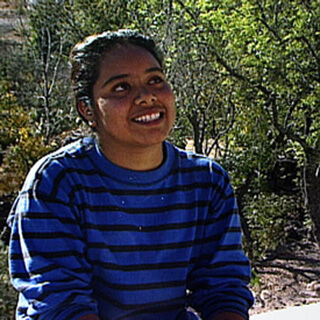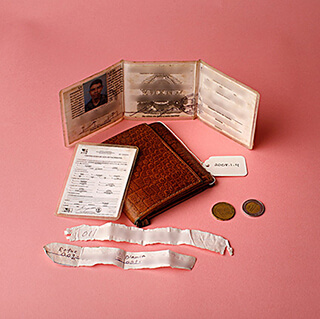Overview
Charles D. Thompson, Jr., ties his experience working with immigrant laborers to border crossings and the interdependency of agricultural workers and economies.This piece stems from Thompson’s multi-media project that includes his 2015 University of Texas publication Border Odyssey: Travels along the U.S./Mexico Divide and the companion website, borderdodyssey.com.
The documentary video featured here, Faces of Time, highlights one chapter of Thompson’s travels along the border—specifically his work with braceros whom he found in a park in the middle of Ciudad Juarez demanding their purloined retirement benefits.
Video
Charles D. Thompson, Los Rostros del Tiempo: Faces of Time, 2014.
Reflection
My border odyssey began in 1985 on a farm near Pittsboro, North Carolina. On a hot summer afternoon I walked out of my farm field to meet five men from Mexico. They drove into my driveway in an old beat up blue Impala, got out in the bloodied knee-length white coats and black rubber boots they'd worn that day in the nearby chicken processing plant, and said they had heard I needed help harvesting blackberries on my farm. As I reached to shake their hands, I felt a powerful sense of relief wash over me. I felt like crying.
I had been successful enough with my farm marketing that there was no way I could pick everything I could sell. Orders had piled up, and the farmers' market was just a few days away. The small group of helpers I'd found for one or two days a week earlier in the summer—three high school students and occasionally one of their grandmas who drove them to the farm—had drifted away to other jobs, from fast food work to babysitting. My wife worked off the farm. My neighbors were all either too old or too busy. I had no extended family nearby. Interns hadn't yet started searching for opportunities on farms. I was doing most everything alone, and there just weren't enough hours of sunlight to get all of the two acres of ripe berries harvested. Soft small bramble fruits are especially vulnerable to heat and they weren't going to wait.
 |
I'd already known that Mexican people, men mostly, had started coming to central North Carolina. I knew many of them processed hogs or poultry, and that others worked on dairy or tobacco farms nearby. I'd even gone to Mexico once the year before. But I never dreamed when I went into small-scale organic farming that I'd ever hire laborers to help me, let alone foreign workers.
Yet, on that hot afternoon thirty years ago, I joined the thousands of farmers and other business owners who have hired people who have traveled some three thousand miles and crossed a desert or a river to save their day and ours. They would only work a few hours two or three times a week for me, but they made it possible for me to salvage my blackberry crop, some of my most important income of the year. Choosing to be paid by the flat, they earned pretty good money, too. They literally ran to the fields that day to get started filling the pints as I carried them empty flats and returned with filled ones to the cooling shed.
Over the coming weeks and months we often worked side-by-side. I took a dictionary to the field and began learning Spanish. Already a lover of stories, I wanted to know how they had traveled from their homes and what it was like to cross the border. I learned firsthand about their harrowing journeys and of the risk to provide money for their families. I also learned that every one of those five men were farmers with families still on their land trying to hold on and grow crops in their absence.
We had a love of farming in common. But it hit me hard when I realized that one huge chasm between us was my freedom to stay in place and their need to leave home to keep their farm alive. I was a beginning farmer hiring seasoned agriculturalists from another country to help make my piece of land more profitable. The disparity began to weigh on me.
 |
Thirty years later, I look back to the day the border first crossed me. That day I began to learn that I was caught up in a globalizing system of economic exchange and interdependency. That day I became part of the process too many have dismissed and not enough acknowledge. Since then, I've studied Spanish formally, gone to graduate school, engaged in fieldwork in Mexico and Central America, written about farmworkers, and made films about immigration and agriculture. The borderlands overtook me personally and professionally. I cannot escape their meaning—not just down at the southern line below the United States, but the little borders everywhere in our lives, the borders especially between the people we depend on in so many ways and the policies that vilify them. I now teach and write about all of this, traveling extensively so I can learn and teach others. My own farm is but a memory.
My latest book, entitled Border Odyssey: Travels Along the U.S./Mexico Divide, is a memoir, a travelogue, an ethnography, history, and, as one reviewer put it, a jeremiad about the border. I chronicled every mile of it from the mouth of the Rio Grande in Texas to the Pacific Coast in California. The website and book featured here are my effort to forge better understanding. And the project is also my tribute to Eusebio, Librado, Faustino, Juan, and Jesus, the five who drove in my driveway, saved my blackberry crop, and changed me forever. 
About the Author
Charles D. Thompson, Jr. is Professor of the Practice of Cultural Anthropology and Documentary Studies at Duke University. An author and filmmaker, Thompson's latest works are Border Odyssey: Travels along the U.S./Mexico Divide (University of Texas Press, 2015), the films Faces of Time and Brother Towns/Pueblos Hermanos, and the book Spirits of Just Men: Mountaineers, Liquor Bosses, and Lawmen in the Moonshine Capital of the World (University of Illinois Press, 2011).
Recommended Resources
Text
Ansley, Fran and Jon Shefner, eds. Global Connections and Local Receptions: New Latino Immigration to the Southeastern US. Knoxville: University of Tennessee Press, 2009.
Anzaldúa, Gloria. Borderlands/La Frontera: The New Mestiza. San Francisco: Spinsters/Aunt Lute, 1987.
Fink, Leon. The Maya of Morganton: Work and Community in the Nuevo New South. Chapel Hill: University of North Carolina Press, 2003.
Odem, Mary and Elaine Lacy, eds. Latino Immigration and the Transformation of the US South. Athens: University of Georgia Press, 2009.
Smith, Heather and Owen Furuseth, eds. Latinos in the New South: Transformations of Place. Burlington, VT: Ashgate Publishing, 2006.
Thompson, Charles D., Jr. Border Odyssey: Travels along the U.S./Mexico Divide. Austin: University of Texas Press, 2015.
Zúñiga, Víctor and Rubén Hernández-León, eds. New Destinations of Mexican Immigration in the United States: Community Formation, Local Responses and Inter-Group Relations. New York: Russell Sage Foundation, 2005.
Web
Thompson, Charles D. Brother Towns: Pueblos Hermanos. Center for Documentary Studies. Duke University. http://www.brothertowns.com/.
Immigrant Justice. Southern Poverty Law Center. http://www.splcenter.org/what-we-do/immigrant-justice.
Passel, Jeffrey S. Testimony of Jeffrey S. Passel–Unauthorized Immigrant Population: National and State Trends, Industries and Occupations. Pew Research Center, Hispanic Trends, 2015. http://www.pewhispanic.org/2015/03/26/testimony-of-jeffrey-s-passel-unauthorized-immigrant-population/.




